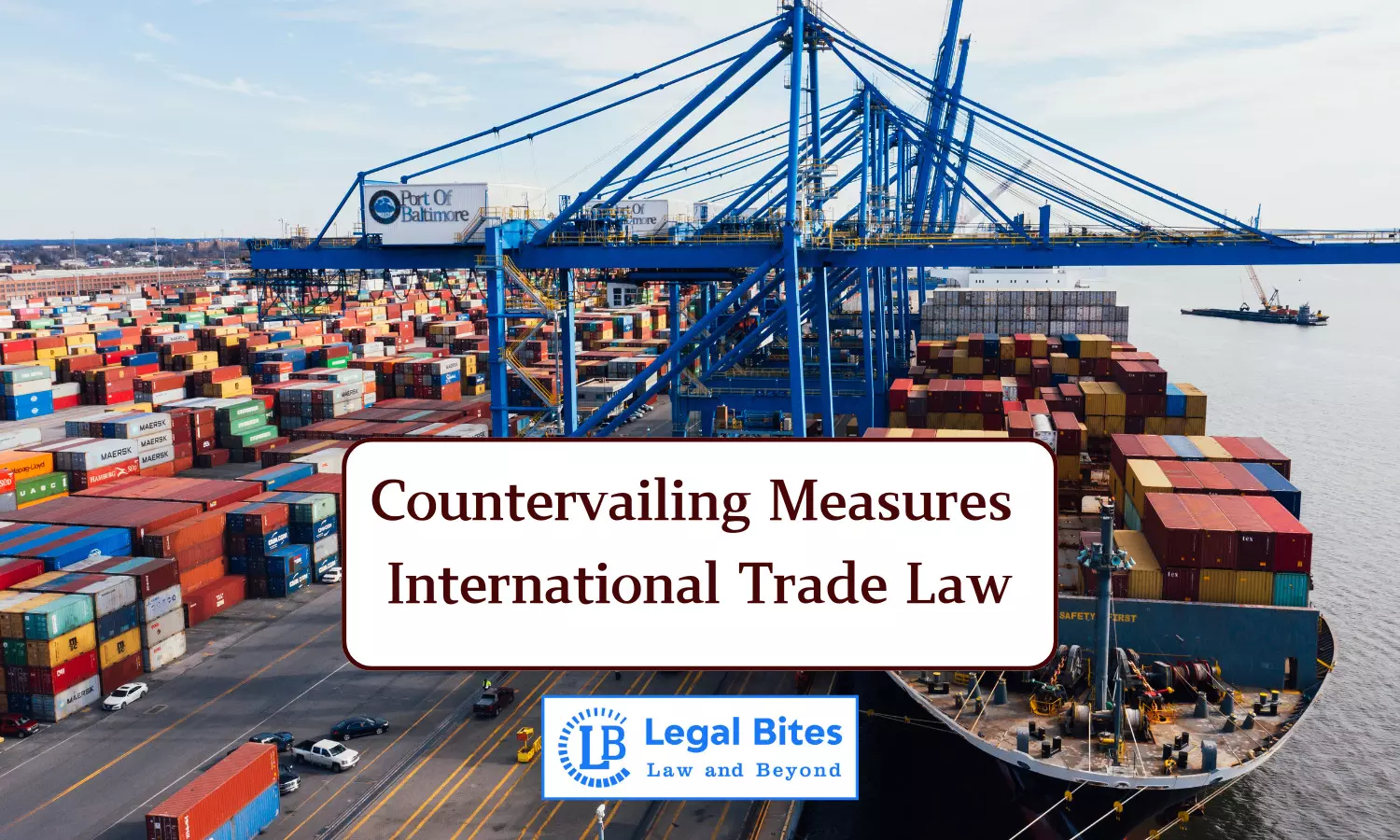Countervailing Measures | International Trade Law
This article explores the role of countervailing measures in international trade law and the challenges involved in their application.

In international trade, government subsidies can play a critical role in shaping competitive advantages for domestic industries. These subsidies, while often beneficial for fostering growth within a country, can distort trade and lead to unfair competitive practices on the global stage.
To address these distortions, the World Trade Organization (WTO) has developed a robust system of rules, including countervailing measures (CVMs). Countervailing measures are a key tool used by countries to counter the negative impacts of foreign subsidies that distort trade and harm domestic industries.
Legal Framework of Countervailing Measures under WTO Law
At the core of international trade law governing countervailing measures is the WTO Agreement on Subsidies and Countervailing Measures (SCM Agreement), which provides the legal structure for the imposition of CVMs. The SCM Agreement, negotiated during the Uruguay Round of trade negotiations (1986–1994), aims to regulate the use of subsidies and the response to their potential negative effects on international trade.
The SCM Agreement defines a subsidy as a financial contribution by a government or any public body that confers a benefit to the recipient. Subsidies are further categorized into prohibited subsidies and actionable subsidies. Prohibited subsidies include those contingent upon export performance or the use of domestic goods over imported goods, while actionable subsidies are those that cause adverse effects on the interests of other WTO members.
When a domestic industry is harmed by subsidized imports, the affected country may impose countervailing measures, such as duties, to neutralize the subsidy’s effect. However, before a CVM can be imposed, the complaining country must demonstrate that the subsidy is specific to certain enterprises or industries and that the domestic industry has suffered material injury as a result. This system ensures that CVMs are not used arbitrarily or as a protectionist tool, aligning with the WTO’s overarching goal of promoting free and fair trade.
The Procedure for Imposing Countervailing Measures
The process for imposing countervailing measures under the SCM Agreement is rigorous and involves several steps. Countries must first undertake a countervailing investigation, following strict guidelines on transparency and procedural fairness. The investigation must prove three critical elements:
Existence of a Subsidy: As mentioned earlier, a government’s financial contribution must confer a benefit on the recipient and be specific to an enterprise or industry.
Injury to Domestic Industry: The importing country must demonstrate that the subsidy has caused material injury or threatens to cause injury to a domestic industry. This is typically measured by factors such as declining sales, loss of market share, suppressed prices, or underutilization of production capacity.
Causal Link: It must be proven that the injury to the domestic industry is directly linked to the subsidized imports. This is often the most contentious part of an investigation, as the injured industry must distinguish the effect of subsidized imports from other factors like changes in consumer demand or general economic conditions.
Once an investigation concludes that these three conditions are met, the importing country may impose countervailing duties on the subsidized imports. These duties are meant to offset the advantage conferred by the subsidy and restore fair competition in the domestic market. According to WTO rules, countervailing measures must not exceed the amount of the subsidy that caused the injury, ensuring that the response is proportionate.
Countervailing Measures in Practice
The application of countervailing measures in international trade has increased over the years, particularly as global trade has expanded and more countries have become major players in export markets. A review of recent countervailing cases reveals that large economies such as the United States, the European Union, and China are frequently involved in disputes concerning subsidies and CVMs.
For instance, the United States' Department of Commerce regularly conducts countervailing duty investigations on products ranging from steel to solar panels, often targeting countries like China for allegedly providing unfair subsidies to their industries. One notable case is the solar panels dispute between the U.S. and China, where the U.S. imposed significant countervailing duties on Chinese solar panel imports. The U.S. claimed that China’s subsidies to its solar industry, including low-interest loans and cheap access to raw materials, gave Chinese companies an unfair advantage, harming U.S. manufacturers.
Similarly, the European Union has also actively pursued countervailing measures, particularly in industries like steel and aluminium. The EU has argued that state support in countries like China and Russia has led to unfair competition and has imposed countervailing duties to protect its domestic producers. The WTO has played an essential role in resolving many of these disputes through its Dispute Settlement Body (DSB), providing a forum where countries can challenge the legality of countervailing measures and seek redress.
Challenges and Controversies Surrounding Countervailing Measures
Despite their importance in maintaining fair competition, countervailing measures are not without challenges. The imposition of these duties often leads to retaliatory actions and can escalate into broader trade disputes. Additionally, proving the existence of a subsidy, establishing injury, and showing causality can be difficult and highly technical processes, leading to lengthy investigations and legal battles.
One of the key challenges in this area is the determination of the “benefit” conferred by a subsidy. In some cases, governments provide support in indirect ways, such as through tax breaks, favourable regulations, or infrastructure development, making it difficult to quantify the exact financial benefit to the recipient. Furthermore, the rise of state-owned enterprises (SOEs), particularly in countries like China, has complicated the application of countervailing measures. SOEs often receive various forms of government support that may not fit neatly into the SCM Agreement’s definitions of subsidies, raising questions about how to address these practices under WTO rules.
Moreover, the growing role of global value chains (GVCs) has added complexity to countervailing measures. Products today are often manufactured in multiple countries, with different stages of production involving various suppliers. This fragmentation of production makes it harder to trace the origin of subsidies and determine their impact on the final product. As a result, some argue that traditional countervailing measures are ill-suited to the realities of modern trade, calling for reforms to better address the challenges posed by GVCs.
The Role of Countervailing Measures in Trade Wars
Countervailing measures have also been used as a tool in broader trade conflicts, most notably in the context of the U.S.-China trade war. Both countries have imposed countervailing duties on a range of products in response to each other’s subsidies, contributing to an escalation of tensions. While the WTO framework is designed to prevent such disputes from spiralling out of control, the U.S.-China trade war has highlighted the limitations of the system in resolving complex, politically charged disputes.
For example, in the U.S.-China trade war, the U.S. accused China of providing massive subsidies to its technology and manufacturing sectors, which it argued allowed Chinese firms to dominate global markets unfairly. In response, the U.S. imposed countervailing duties on a wide range of Chinese imports, while China retaliated with its duties. These actions not only disrupted trade flows but also sparked broader concerns about the erosion of the multilateral trading system.
Reforming the SCM Agreement: A Way Forward?
Given the challenges and controversies surrounding the application of countervailing measures, many experts and policymakers have called for reforms to the WTO’s subsidy rules. Some have proposed expanding the definition of subsidies to include non-monetary forms of government support, such as regulatory advantages or preferential access to resources. Others have suggested strengthening the enforcement mechanisms of the SCM Agreement, ensuring that countries comply with the rules and that disputes are resolved more quickly and effectively.
Additionally, there have been calls for greater transparency in the reporting of subsidies. The SCM Agreement requires WTO members to notify their subsidies to the organization, but compliance with this obligation has been uneven. Strengthening these notification requirements could help improve the effectiveness of countervailing measures by providing clearer information about the scope and nature of subsidies.
Conclusion
Countervailing measures play a critical role in the international trade regime by ensuring that government subsidies do not distort competition and harm domestic industries. While the WTO’s SCM Agreement provides a robust legal framework for the application of CVMs, challenges remain in providing subsidies, determining injury, and addressing modern trade complexities like global value chains.
As trade disputes continue to arise, particularly involving major economies like the U.S. and China, the importance of effective and transparent countervailing measures will only grow. The future of CVMs may depend on ongoing efforts to reform and strengthen the global trade system, ensuring that it remains equipped to address the evolving challenges of a rapidly changing world.
References
[1] Agreement on Subsidies and Countervailing Measures (SCM Agreement), Available Here
[2] Implications of WTO Disciplines for Special Economic Zones in Developing Countries, Available Here
[3] The Economics of WTO Rules on Subsidies and Countervailing Measures, Available Here
[4] United States — Countervailing Duty Measures on Certain Products from China, Available Here

